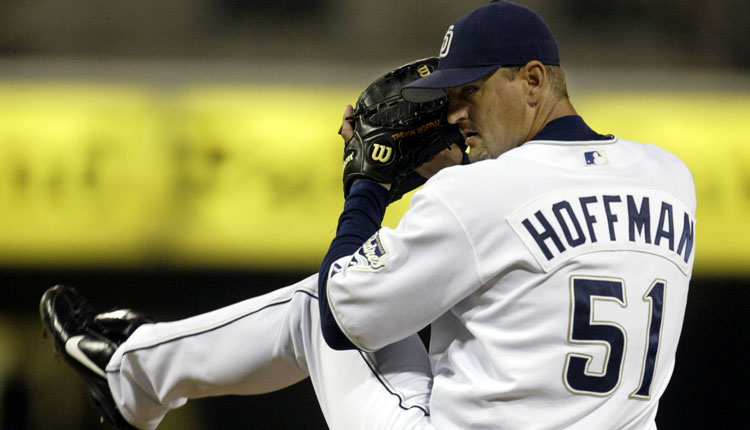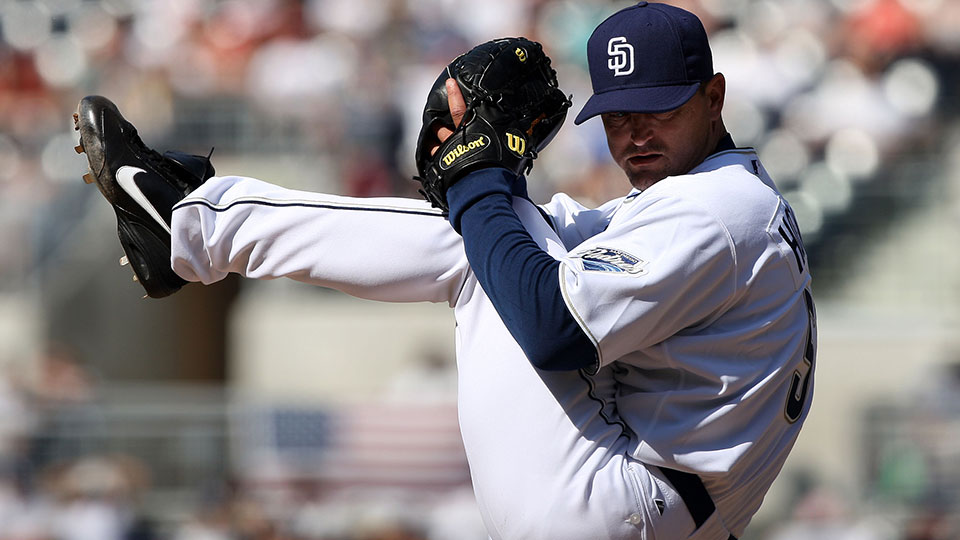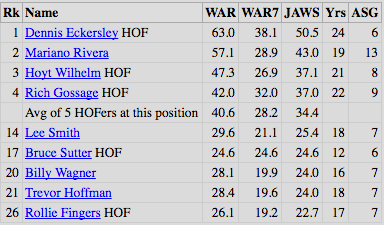Trevor Hoffman: Hall of Fame-Bound or Likely Snub?


Moving on to a more complex argument, one of the best ways to measure a player’s Hall of Fame credentials is through JAWS (Jaffe WAR Score system).
It was originally created by Jay Jaffe at Baseball Prospectus in 2004.
To explain in a more simplified way, the JAWS system is used to measure a player’s Hall of Fame worthiness by comparing his body of work to those already in the Hall at the same position. The measure uses both advanced statistics and statistical adjustments to account for differences based on time period to get a good approximation of player value by comparison. At its basis, JAWS is an average of a player’s career WAR and his seven-year peak WAR, which is not necessarily consecutive years, to get a number that can be compared across eras for players of the same position.
To start with, there are currently only five relief pitchers who have been enshrined into the Hall. For reference, those are Rollie Fingers, Hoyt Wilhelm, Rich Gossage, Bruce Sutter, and Dennis Eckersley.
Of those, only two, Rollie Fingers and Hoyt Wilhelm, actually spent the vast majority of their careers in a relief role. For further comparison, we will add both Billy Wagner and Lee Smith, who are also trying to get elected into the Hall of Fame from the relief pitcher position this year. For fun, I will also be throwing in Mariano Rivera, who is almost a lock to be elected to the Hall of Fame once he becomes eligible.
Below is a chart that compares all the player’s listed above, as well as Trevor Hoffman, based on career WAR, the cumulative WAR of their seven peak seasons, and their respective JAW scores.
One important distinction that must be made on the below information can be seen in row five, which states the averages for career WAR, seven-year peak WAR, and JAWS scores for each of the five relief pitchers already inducted into the hall of fame. Those numbers average out to a career WAR of 40.6, a seven-year peak WAR of 28.2, and a JAWS score of 34.4.

For reference, the table above is in order of JAWS scores, with the players’ rankings among all relief pitchers in baseball history to the left of their name (for the purposes of this comparison, some players were taken out).
Based on the table, it is easy to see where Trevor Hoffman ranks. In terms of all three measurements, career WAR, seven-year peak WAR, and JAWS, Hoffman falls below the average of the five current Hall of Fame relief pitchers. While Hoffman does fall 8th on the list in terms of JAWs scores, he does have a higher such score than Hall of Fame inductee Rollie Fingers. In terms of career WAR, Hoffman finishes sixth on this list, once again ahead of current Hall of Famer Fingers and also Hall of Famer Bruce Sutter. Finally, in terms of seven-year peak WAR, Hoffman comes in 8th place but is one more time ahead of Fingers.
These numbers bring back a somewhat inconclusive result. Perhaps Hoffman did have a better career than, or at least a career on par with, current Hall of Fame relievers Rollie Fingers and Bruce Sutter. Despite that, Hoffman did fall below the average of the five current Hall of Fame relievers on all three categories measured. Based on those numbers alone, one could make a case either way that Hoffman deserves to be in the Hall of Fame. With such a deep potential class in 2016, this year may not be the year Hoffman gets in. However, based on his performance over his career with the Padres, notching 601 saves as one of the faces of the franchise, Hoffman should be elected to the Hall of Fame at some point in the future.
While I originally wrote the above piece at the beginning of 2016, a mere weeks before the 2016 Hall of Fame induction ceremony in which Ken Griffey and Mike Piazza were given spots in the Hall of Fame, the discussion is still a heated one even today, as we near the 2018 Hall of Fame ceremony. Right-handed Padres’ legend Trevor Hoffman is now going into his third year on the ballot, and his Hall of Fame case looks as uncertain as ever. After receiving only 67.3 percent of the vote in his first year on the ballot, almost eight percentage points shy of the 75 percent threshold, Hoffman got even closer in 2017, receiving 74 percent of the vote and ending up just a few points shy of that 75 percent threshold.
Going into 2018, it seems like Hoffman would be a slam dunk Hall of Fame candidate based on his uptick in vote percentage over his first two years on the ballot. However, Hoffman faces some rather stiff competition in his third year on the ballot. Names like Vladimir Guerrero, Edgar Martinez, Roger Clemens, Barry Bonds, Mike Mussina, Curt Schilling, Manny Ramirez, Larry Walker, Fred McGriff, Jeff Kent, Gary Sheffield, Billy Wagner, and Sammy Sosa are all returning to the 2018 ballot, while new additions like Chipper Jones, Jim Thome, Scott Rolen, Andruw Jones, Johan Santana, and others further muddy what is already a very hectic process. Picking ten names from that list is a somewhat Herculean task, so it’s hard to imagine Hoffman being a slam dunk for 75 percent of the vote with so many other worthy names.

However, the argument has somewhat deviated from Hoffman not being worthy given the options, to him not being worthy given his role as a relief pitcher. It’s rather difficult to compare a relief pitcher who threw just under 1,100 innings to pitchers who threw over 3,000 innings like Mike Mussina, or nearly 5,000 innings like Roger Clemens. It’s even more challenging to compare someone like Hoffman to someone like Barry Bonds, who batted nearly 10,000 times while playing in almost 3,000 games. This makes the whole proposition rather tricky because there is no defined set of rules dictating who should be in the Hall and who should not be.
The only real rules to Hall of Fame voting are that any elector can only select up to 10 names for any given year. Beyond that, the voting rules, which will be listed below, leave the vote up to some degree of interpretation.
Voting shall be based upon the player’s record, playing ability, integrity, sportsmanship, character, and contributions to the team(s) on which the player played.
If you would like to parse the above words into something that resembles a cut and dried way to screen candidates, be my guest, but it seems to be inherently a fool’s errand. Given how open-ended these rules are, it’s easy to imagine an argument being made for a wide variety of players, including relief pitchers. If relief pitchers had a strong playing record with strong ability, and integrity, sportsmanship, character, and other intangibles, why are they any less deserving of a place in the Hall of Fame than non-relief pitchers. Penalizing players for an artificially created role seems in its most basic form to be unfair. At worst, it’s borderline hypocrisy.
At the end of the day, relief pitchers exist in the baseball universe. It is a defined role, and one that has grown in importance as the years have gone on. Given how much of an effect relief pitchers had on the last few years of the playoffs, it’s abundantly clear that relief pitchers not only have their role in the current game of baseball, but also have their place in the Hall of Fame on top of that. You can certainly make the argument that Hoffman is not as strong a candidate as the likes of Mariano Rivera, or several relief pitchers already in the Hall, but you can’t say relief pitchers shouldn’t be allowed in, especially given that there are already several relief pitchers in.
So where does this leave Hoffman’s Hall of Fame case in 2018? There is a very real possibility that Hoffman won’t be selected in his third year on the ballot. However, it won’t be because he is a relief pitcher or his credentials don’t stack up. It will be because there are plenty of other deserving candidates on the ballot, which could lead to several deserving players being left out of the Hall, at least in 2018. If I had a 2018 ballot, it would be hard for me to find a spot for Hoffman due to the multitude of options. However, that doesn’t mean he isn’t deserving of the same recognition bestowed upon the likes of Dennis Eckersley, Bruce Sutter, Rollie Fingers, and others. Trevor Hoffman should be a Hall of Famer, not only for his contributions on the field, but his contributions to his teammates, his clubhouse, his fans, the entire city of San Diego, and the game of baseball itself.
Editorial and Prospect Writer for East Village Times. Twenty-five years young, Patrick has lived in San Diego for his entire life and has been a Padres fan nearly as long. Patrick lives for baseball and is always looking to learn new things about the game he loves through advanced stats.